Posts Tagged Turkey
Day 27 – Two Weddings and a Satellite
Posted by Musical Nomad in Daily Blog on August 24, 1997
 We have set up the satellite in many strange places – it is surprising the number of times we have managed to get a clear view of the Indian Ocean receiver without venturing beyond the nearest road. Sadly there have been too many times when mountains, trees or Soviet apartment blocks have got in the way. Today we had to go somewhere. In a children’s playground in the suburbs of Biskek, Kyrgyzstan, English Nomads could be seen setting up a bizarre array of equipment – morning entertainment for the youngsters. The sound of a motor generator and sight of a ‘sputnik’ in the middle of their playground was too much to resist. After some confused policemen had left us a throng of children gathered and cheered us on as we connected to the world. No big flashing lights or music just Gary saying ‘great – another one off’. We asked them to return at 10 PM for part two.
We have set up the satellite in many strange places – it is surprising the number of times we have managed to get a clear view of the Indian Ocean receiver without venturing beyond the nearest road. Sadly there have been too many times when mountains, trees or Soviet apartment blocks have got in the way. Today we had to go somewhere. In a children’s playground in the suburbs of Biskek, Kyrgyzstan, English Nomads could be seen setting up a bizarre array of equipment – morning entertainment for the youngsters. The sound of a motor generator and sight of a ‘sputnik’ in the middle of their playground was too much to resist. After some confused policemen had left us a throng of children gathered and cheered us on as we connected to the world. No big flashing lights or music just Gary saying ‘great – another one off’. We asked them to return at 10 PM for part two.
 I had the opportunity to spend a late Sunday afternoon walking through Biskek with our new Kyrgyz translator Gulnaz Abdrahmanova. It has been 42 degrees for the last few weeks. Now, after a sudden rain, the weather is typically British and a welcome change for the team. One of the first things that strikes me is the people – they are, like in Almaty, dressed in ‘modern’ clothes, very different from the traditional Muslims of the Fergana Valley of two days ago. The city itself is wide, open and filled with Soviet style buildings and monuments. As we walked through Dubovy park filled with decaying carvings, Gulnaz explained how Biskek had bought up many Russian artifacts from other ex-Soviet countries – they were quite keen to pass them on! Biskek is the most ‘Russian’ city we have visited. It is the only ex-CIS city with a statue of Lenin still dominating it’s main square. It is difficult to know how most of the city react to these relics. Will Lenin last much longer? The people do seem proud of some of thier monuments, especially Urkuya Saliyevas a reformer from Osh who led the Kyrgyz female movement after the revolution.
I had the opportunity to spend a late Sunday afternoon walking through Biskek with our new Kyrgyz translator Gulnaz Abdrahmanova. It has been 42 degrees for the last few weeks. Now, after a sudden rain, the weather is typically British and a welcome change for the team. One of the first things that strikes me is the people – they are, like in Almaty, dressed in ‘modern’ clothes, very different from the traditional Muslims of the Fergana Valley of two days ago. The city itself is wide, open and filled with Soviet style buildings and monuments. As we walked through Dubovy park filled with decaying carvings, Gulnaz explained how Biskek had bought up many Russian artifacts from other ex-Soviet countries – they were quite keen to pass them on! Biskek is the most ‘Russian’ city we have visited. It is the only ex-CIS city with a statue of Lenin still dominating it’s main square. It is difficult to know how most of the city react to these relics. Will Lenin last much longer? The people do seem proud of some of thier monuments, especially Urkuya Saliyevas a reformer from Osh who led the Kyrgyz female movement after the revolution.

Along the main street there is the familiar mix of subway markets, karaoke cafes and photographer stalls. There are eccentric props used by the photographers including large white gorillas, dead birds in a palm trees and broken down cars. One street stall that caused the team much surprise was an evil spirit removal and fortune telling service. A man in jeans and green shirt waved his arms and hissed Shaman-like chants around each customer. A queue of women sat in the open as each were treated in turn. Our presence caused some embarrassment but we were told this service is very much in demand. Gulnaz’s husband goes once a year and she told me how valuable it was to him. I found it so strange to see this kind of thing performed so openly and I thought how much it differed from our meeting with Shaykh Kushkarov on day 20.
The musician, Kurmangazy Aiylchievich who we are going to meet tomorrow, is larger than life. There is something about him that reminds me of Shoberdy – the Baysun Bakshy [see Day16]. He is a wild, flamboyant virtuosic vodka drinker. Unlike Shoberdy he talks extravagantly about musical healing, Shamans and holistic principles but also plays popular hits at public functions.

By reputation Kurmangazy is Kyrgyzstan’s top musician. I’ve been invited by Kurmangazy to a special location. A double celebration of a 70th birthday and a 50th wedding anniversary. As I climb the staircase of the ‘Kyrgyz National Restaurant’, I’m immediately struck by a sea of hats – the white Alpine-like national hat of the Kyrgyz nomads. The old women all wear head scarves softening their sun-gold faces, few smile, their heads filled with memories?
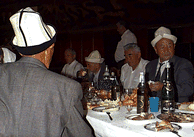
The details vary but I’m sure these occasions have common ground the world over. Solemn vodka laced speeches about ‘fifty happy years,’ on a stage decorated with bouquets and fruit. Children reluctantly pushed to the front, perform party pieces – this time on the national instrument, the komuz. A special delicacy is presented to table – today it’s horse meat – another nomad symbol? Perhaps amongst the gossip there is nostalgia for a Soviet era of greater prosperity and a more certain infrastructure. Nostalgia tempered now by an influx of jobs in fizzy soft drink factories and the fluorescent appeal of catalogue fashions – it’s Sunday and everybody looks their best. In the key of slightly Eb auntie Flo will sing a song: ‘Her mother should know’ – the band struggles to follow.
 Special occasions need special music and Kurmangazy seemed happy to provide the crowd-pleasers. To European ears his band is a bizarre cocktail of popular Kyrgyz melodies, South American music, Jazz and Classical pops. His band are all accomplished conservatoire-trained musicians and appear very relaxed.
Special occasions need special music and Kurmangazy seemed happy to provide the crowd-pleasers. To European ears his band is a bizarre cocktail of popular Kyrgyz melodies, South American music, Jazz and Classical pops. His band are all accomplished conservatoire-trained musicians and appear very relaxed.
 Kurmangazy fronts the band with a frantic energy, swapping frequently between his many wind instruments. The band’s funked-up versions of everything receive a somewhat cool response from the audience of over 50s. The medley of ‘Classic’ hits which Kurmangazy dedicated to us included snippets of Bach, Mozart and Paganini, all arranged in a ‘hooked-on-Classics’ style with a synthesised back-beat. He invited us to attend a healing session he will conduct at midnight!
Kurmangazy fronts the band with a frantic energy, swapping frequently between his many wind instruments. The band’s funked-up versions of everything receive a somewhat cool response from the audience of over 50s. The medley of ‘Classic’ hits which Kurmangazy dedicated to us included snippets of Bach, Mozart and Paganini, all arranged in a ‘hooked-on-Classics’ style with a synthesised back-beat. He invited us to attend a healing session he will conduct at midnight!
Once again the team have to extricate themselves from a tricky situation. We are invited to stay and drink endless vodkas and eat horse with the band. Horse intestines are a local delicacy and it testifies to the wealth of the host that it was in plentiful supply. We were told each horse makes four plates of ‘delicacy’ and costs about 1500 USD. We decide to sneak off and send you this transmission.
 Emerging into the street we encounter a traditional wedding in full flight. Two surnai (shawm) players and a drummer play spiralling polyrhythmic music that makes you want to dance. The bride, groom and entourage arrive and a circle dance starts up in the street. Money is pushed into the hands of the dancers. There is a strong link here with the music of Turkey (the Kyrgyz people are a Turkic people) but the surnai is also very similar to the ghaita of Morocco. In France there is a similar double-reed instrument, the bombard. The double headed drum exists worldwide and in France it is known as the tabor. These connections must be well documented, but to see it in real life gives a startling sense of the cultural overlap between Europe and Asia.
Emerging into the street we encounter a traditional wedding in full flight. Two surnai (shawm) players and a drummer play spiralling polyrhythmic music that makes you want to dance. The bride, groom and entourage arrive and a circle dance starts up in the street. Money is pushed into the hands of the dancers. There is a strong link here with the music of Turkey (the Kyrgyz people are a Turkic people) but the surnai is also very similar to the ghaita of Morocco. In France there is a similar double-reed instrument, the bombard. The double headed drum exists worldwide and in France it is known as the tabor. These connections must be well documented, but to see it in real life gives a startling sense of the cultural overlap between Europe and Asia.
Tomorrow we meet the extraordinary Kurmangazy again and hope to discover more about both his music and his research into ancient Kyrgyz culture.
Day 21 – the person who arrives is not the one who left
Posted by Musical Nomad in Daily Blog on August 18, 1997
Yesterday I found myself reflecting on some words from day 0
‘the person who arrives is not the one who left’.
 This trip has been very intense for me. Meeting so many people, visiting so many places in such a short span. Some ‘moments’ have had a profound effect on me. Day 4, as I encountered the intense Shamanistic music of Raushan and her kobuz. Day 7, hearing Munadjat moved me to tears. Day 11, the quiet reflection of Hoja Ismail al Bukhari?s Tomb. Day 12, the intimacy and humour of a family lunch with ‘the last of his kind’, Ari Babakhanov. Day 13, at last the satellite works and I share my discoveries and invite your questions. Day 16, I meet the wild man of Baysun, Shoberdy Bakshy who dares to dance to a different drum. Yesterday the Sufi Shayk Kushkarov astounded me with his strength of spirit, generosity and wit. The internet site though is the tip of an iceberg.
This trip has been very intense for me. Meeting so many people, visiting so many places in such a short span. Some ‘moments’ have had a profound effect on me. Day 4, as I encountered the intense Shamanistic music of Raushan and her kobuz. Day 7, hearing Munadjat moved me to tears. Day 11, the quiet reflection of Hoja Ismail al Bukhari?s Tomb. Day 12, the intimacy and humour of a family lunch with ‘the last of his kind’, Ari Babakhanov. Day 13, at last the satellite works and I share my discoveries and invite your questions. Day 16, I meet the wild man of Baysun, Shoberdy Bakshy who dares to dance to a different drum. Yesterday the Sufi Shayk Kushkarov astounded me with his strength of spirit, generosity and wit. The internet site though is the tip of an iceberg.
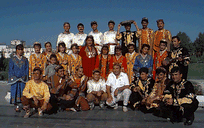 After tracking the Baysun Ensemble several hundred kilometres across Uzbekistan, we finally caught up with them in Tashkent. They assembled in Friendship Square at 3.00 in the afternoon heat. Despite the conditions we managed to catch a brief example of their unique brand of folk music. The Ensemble is large, 45 people including musicians and dancers. We only saw 30 of them today, but I still had the impression of a village collectively telling a story. Baysun itself is renowned for its music [see Day 16] and the
After tracking the Baysun Ensemble several hundred kilometres across Uzbekistan, we finally caught up with them in Tashkent. They assembled in Friendship Square at 3.00 in the afternoon heat. Despite the conditions we managed to catch a brief example of their unique brand of folk music. The Ensemble is large, 45 people including musicians and dancers. We only saw 30 of them today, but I still had the impression of a village collectively telling a story. Baysun itself is renowned for its music [see Day 16] and the
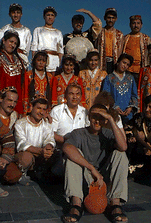 Ensemble have a considerable reputation in Uzbekistan. Established for ten years they have travelled widely, including UK, Turkey, Bulgaria and USA. Their music might be described as folk revival, aiming for a reconstruction of traditional music about everyday life. It is a long way from the Russian inspired ‘folkloric’ groups, and retains something of the simplicity and directness of authentic folk music. Stories and poems are sung and semi-staged. The repertoire is adapted for the concert hall and is very well rehearsed. Its naturalness conceals years of painstaking reconstruction, mostly from oral sources. They now adapt traditional melodies to modern texts.
Ensemble have a considerable reputation in Uzbekistan. Established for ten years they have travelled widely, including UK, Turkey, Bulgaria and USA. Their music might be described as folk revival, aiming for a reconstruction of traditional music about everyday life. It is a long way from the Russian inspired ‘folkloric’ groups, and retains something of the simplicity and directness of authentic folk music. Stories and poems are sung and semi-staged. The repertoire is adapted for the concert hall and is very well rehearsed. Its naturalness conceals years of painstaking reconstruction, mostly from oral sources. They now adapt traditional melodies to modern texts.
 I sat down with their manager, Abdunabi Ravshanov and their musical director and flute player, Habib Umarov. After some discussion about the Group’s history and current activities, I asked about the similarities between their music and the music of the Balkans, particularly Bulgaria. This similarity had struck me particularly strongly this afternoon. Habib said that Uzbeks and Bulgars had mixed with Turkic people. I took out my flute and played a Turkish melody. Habib’s face flashed a smile of recognition. Within seconds he was playing along and I was trying to imitate some of his ornamentation and variations. It seems this tune is from Istanbul. We each knew slightly different versions but it was undoubtedly the same melody. It was a strange but hard-warming feeling to be sitting in a Tashkent hotel with a Baysun flute player playing a melody from Istanbul.
I sat down with their manager, Abdunabi Ravshanov and their musical director and flute player, Habib Umarov. After some discussion about the Group’s history and current activities, I asked about the similarities between their music and the music of the Balkans, particularly Bulgaria. This similarity had struck me particularly strongly this afternoon. Habib said that Uzbeks and Bulgars had mixed with Turkic people. I took out my flute and played a Turkish melody. Habib’s face flashed a smile of recognition. Within seconds he was playing along and I was trying to imitate some of his ornamentation and variations. It seems this tune is from Istanbul. We each knew slightly different versions but it was undoubtedly the same melody. It was a strange but hard-warming feeling to be sitting in a Tashkent hotel with a Baysun flute player playing a melody from Istanbul.
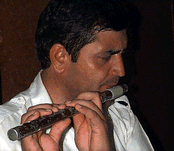 It crossed my mind that because musicians seem to pick up tunes wherever they hear them, the music itself becomes nomadic – it travels. This has always been the case. Habib played ‘What do we do with the drunken sailor?’ to which he knew a strange variation on the words presumably picked up on a tour of the UK. On day 2 Abylai played us an Italian tune, on day 18 the chang player in Samarkand entertained us with Mozart. With my Russian limited to one or two words this is by far the best way to get acquainted.
It crossed my mind that because musicians seem to pick up tunes wherever they hear them, the music itself becomes nomadic – it travels. This has always been the case. Habib played ‘What do we do with the drunken sailor?’ to which he knew a strange variation on the words presumably picked up on a tour of the UK. On day 2 Abylai played us an Italian tune, on day 18 the chang player in Samarkand entertained us with Mozart. With my Russian limited to one or two words this is by far the best way to get acquainted.
The journey continues, we turn another corner. The Shaman eludes us, and we still only glimpse real yurts on distant hill sides. 19 more days, tomorrow the Ferghana valley and then onward to Krygyzstan.
Day 14 – To succeed this project must be interactive
Posted by Musical Nomad in Daily Blog on August 11, 1997
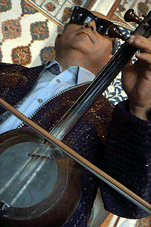 In the same way that a musician craves an audience I must hear from you. I invite you to help produce this exploration into Central Asian music – do you wish to know more about vocal music or instrumental? Are you interested in the related art of dance? Looking back on the previous pages, did we leave any questions unanswered? Are you gaining a clearer picture of this rich culture? Would you like to hear more from any of the featured musicians? – we have up to three recordings of each player. Are we telling you enough about the cultural context? Are you interested in the history, the religion or indeed the politics? We can’t promise all the answers, we will give it our best. Be a director in this bold new medium, I invite you to call the shots.
In the same way that a musician craves an audience I must hear from you. I invite you to help produce this exploration into Central Asian music – do you wish to know more about vocal music or instrumental? Are you interested in the related art of dance? Looking back on the previous pages, did we leave any questions unanswered? Are you gaining a clearer picture of this rich culture? Would you like to hear more from any of the featured musicians? – we have up to three recordings of each player. Are we telling you enough about the cultural context? Are you interested in the history, the religion or indeed the politics? We can’t promise all the answers, we will give it our best. Be a director in this bold new medium, I invite you to call the shots.
Meeting Ulmas Rasulov, Uzbekistan’s foremost classical ghidjak player, was an unforgettable 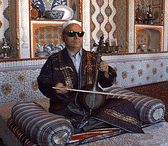 experience. The ghidjak is a spike fiddle and has many similarities to the violin. It has a short neck attached to a gourd shaped soundboard and has a slightly shrill timbre which can only be controlled by very experienced players. Ulmas, who is totally blind, communicates straight from the heart with an incredible openess and honest sensitivity. He has an awareness of the people around him that transcended his lack of sight. He talked to Kathrin and she found it a wonderful surprise to hear that the cello is his favourite European instrument. He suggested she immediately get a cello and play a few duets with him. Ulmas has a great passion for European music, especially Spanish and although the pieces he played were traditional, they exhibited influences far and wide. He played with a deeply felt passion and intensity that touched us all.
experience. The ghidjak is a spike fiddle and has many similarities to the violin. It has a short neck attached to a gourd shaped soundboard and has a slightly shrill timbre which can only be controlled by very experienced players. Ulmas, who is totally blind, communicates straight from the heart with an incredible openess and honest sensitivity. He has an awareness of the people around him that transcended his lack of sight. He talked to Kathrin and she found it a wonderful surprise to hear that the cello is his favourite European instrument. He suggested she immediately get a cello and play a few duets with him. Ulmas has a great passion for European music, especially Spanish and although the pieces he played were traditional, they exhibited influences far and wide. He played with a deeply felt passion and intensity that touched us all.
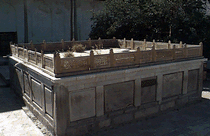 Ulmas told us later that the ghidjak “connects with the heart and soul of the people in Central Asia.” To him this is sacred music, “the music of God”. He feels that together with the sato (another bowed string instrument) and surnai (a reed instrument), the ghidjak comes closest to the human voice. He adds that the voice is the most important ‘instrument’ here and all other instruments aspire to its qualities.”In post-Islamic and pre-revolutionary Transoxania the whole of artistic culture, literature, music and architecture was based on Sufi ideas.”
Ulmas told us later that the ghidjak “connects with the heart and soul of the people in Central Asia.” To him this is sacred music, “the music of God”. He feels that together with the sato (another bowed string instrument) and surnai (a reed instrument), the ghidjak comes closest to the human voice. He adds that the voice is the most important ‘instrument’ here and all other instruments aspire to its qualities.”In post-Islamic and pre-revolutionary Transoxania the whole of artistic culture, literature, music and architecture was based on Sufi ideas.”
Alexander Djumaev (Sasha)
 On our travels I’ve had many opportunities to chat to our friend and musical adviser, Dr Alexander Djumaev. Sasha is a leading musicologist and historian who is particularly interested in the relationship between Sufism and culture. He is a mine of information and has been responsible for introducing us to some extraordinary musicians. I too have become extremely interested to discover more about a mystical tradition that has inspired such an extraordinary culture. As part of this quest I felt it would be important to visit the tomb of Bahauddin Naqsband who is a ‘patron saint’ here in Bukhara.
On our travels I’ve had many opportunities to chat to our friend and musical adviser, Dr Alexander Djumaev. Sasha is a leading musicologist and historian who is particularly interested in the relationship between Sufism and culture. He is a mine of information and has been responsible for introducing us to some extraordinary musicians. I too have become extremely interested to discover more about a mystical tradition that has inspired such an extraordinary culture. As part of this quest I felt it would be important to visit the tomb of Bahauddin Naqsband who is a ‘patron saint’ here in Bukhara.
The tomb is now part of a large complex which includes a mosque, an old dervish house, a museum, a cafe, gardens and of course the gnarled old mulberry tree, reputedly planted by Bahauddin himself. Legend has it that wishes will be granted and women made fertile by passing under the tree three times. There is the air of a tourist complex about the place. It is not until you approach the tomb that the intensity of feeling he engenders becomes apparent. A Koran reciter sits under a shady tree, people join him to have suras recited for dead relatives or just to hear them. An elderly gentleman’s voice chokes with emotion as he prays. The pleading and emploring in his voice makes me feel somewhat uncomfortable. It is like witnessing someone’s distress. This is the same yearning that comes across in some of the music we have heard here, especially maqam.People bring their children here and walk three times around the tomb for luck. Women kiss and stroke the old mulberry tree. Whether or not any of those people maintain a practical connection with the Sufi tradition is unclear.
 Long beforethe revolution the Naqsbandi Order travelled to Turkey and India. There are now branches of the order all over the world. It is undergoing a revival, instigated by influences from outside. I do not know if I have discovered anything new
Long beforethe revolution the Naqsbandi Order travelled to Turkey and India. There are now branches of the order all over the world. It is undergoing a revival, instigated by influences from outside. I do not know if I have discovered anything new
today, but I have gained an insight into the devotion that people here have for this great Sufi teacher.
Tomorrow I go, for the first time, into the mountains near Baysun to seek out a Bakshy and the legendary Baysun Ensemble.
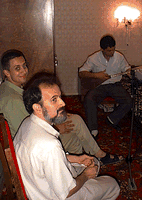 As one of the guitarists and sitarist in our team I’m fascinated by the ‘lutes’ we encounter. I’ve just been lent a dutar by Abdurahim Hamidov. Living with the dutar, having it around my room playing it, I feel invited in to a sort of magic. It has made me incredibly aware of the close relationship between all these Central Asian instruments and most of the world’s ‘lutes’. The two-stringed dombras and dutars have all the latent characteristics of the guitar, the Oud and the sitar. The tuning in fourths (and fifths), the tendency to play parallel patterns up and down the fingerboard – the modal scales are all common to these more familiar instruments. The rasguedo of the dutar is almost “flamenco” in character. The vibrato and portamento techniques are reminiscent of the classical Oud of Arabia.
As one of the guitarists and sitarist in our team I’m fascinated by the ‘lutes’ we encounter. I’ve just been lent a dutar by Abdurahim Hamidov. Living with the dutar, having it around my room playing it, I feel invited in to a sort of magic. It has made me incredibly aware of the close relationship between all these Central Asian instruments and most of the world’s ‘lutes’. The two-stringed dombras and dutars have all the latent characteristics of the guitar, the Oud and the sitar. The tuning in fourths (and fifths), the tendency to play parallel patterns up and down the fingerboard – the modal scales are all common to these more familiar instruments. The rasguedo of the dutar is almost “flamenco” in character. The vibrato and portamento techniques are reminiscent of the classical Oud of Arabia.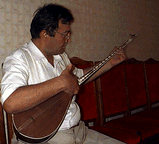 Abdurahim Hamidov who I met today is an incredible virtuoso on the dutar. He also knows many of the other lutes of the area and explained their relationship. According to Abdurahim the dombra which we heard a lot of in Kazakstan is primarily a folk instrument. Though if you refer back to Day 4, you can hear that Aygul Ulkenbaeva is now taking the dombra to a more sophisticated level.Abdurahim regards his dutar as a classical instrument, especially in the context of the Shash maqam though he often performs solo as well as accompanying singers.
Abdurahim Hamidov who I met today is an incredible virtuoso on the dutar. He also knows many of the other lutes of the area and explained their relationship. According to Abdurahim the dombra which we heard a lot of in Kazakstan is primarily a folk instrument. Though if you refer back to Day 4, you can hear that Aygul Ulkenbaeva is now taking the dombra to a more sophisticated level.Abdurahim regards his dutar as a classical instrument, especially in the context of the Shash maqam though he often performs solo as well as accompanying singers.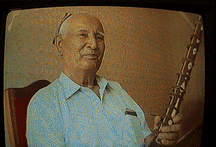 Wow, another lute – today we met Pattahon Mamadaliev, a fantastic 70 year old guy. He sings with a consuming passion and accompanies himself on the tanbur. It has four bronze strings. In India bronze is a sacred metal, I must check out its significance here. The tanbur has very thick gut frets to enable a deep vibrato, it’s made from mulberry and apricot. Pattahon possesses an intensity of performance and a sincere unmannered humility. I played some Spanish lute music for the musicians, Pattahon and Abdurahim. Abdurahim said he understood this 15th century lute music perfectly, which is interesting. This music is very polyphonic ‘in many parts’ as opposed to most Central Asian music which is often monodic. They also enjoyed a bit of pseudo-Flamenco – this is also interesting as Pattahon’s passion and style is reminiscent of Canto Joto from Andalucia in Southern Spain, a deep form of flamenco. Somebody must have told the lute to “go forth and multiply “- I’m ever more convinced that the lute family originated here as most scholars assert.
Wow, another lute – today we met Pattahon Mamadaliev, a fantastic 70 year old guy. He sings with a consuming passion and accompanies himself on the tanbur. It has four bronze strings. In India bronze is a sacred metal, I must check out its significance here. The tanbur has very thick gut frets to enable a deep vibrato, it’s made from mulberry and apricot. Pattahon possesses an intensity of performance and a sincere unmannered humility. I played some Spanish lute music for the musicians, Pattahon and Abdurahim. Abdurahim said he understood this 15th century lute music perfectly, which is interesting. This music is very polyphonic ‘in many parts’ as opposed to most Central Asian music which is often monodic. They also enjoyed a bit of pseudo-Flamenco – this is also interesting as Pattahon’s passion and style is reminiscent of Canto Joto from Andalucia in Southern Spain, a deep form of flamenco. Somebody must have told the lute to “go forth and multiply “- I’m ever more convinced that the lute family originated here as most scholars assert.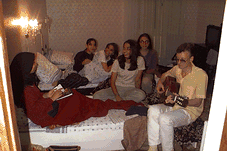 got caught last night serenading five Muslim girls in their bedroom – their father just laughed and went to bed – not the expected reaction. The girls enjoyed a Bo-Diddly song but thought Shash maqam was ‘pretty cool’. They are on holiday from Chicago, so that probably explains their frankly modern behaviour. Jan still has the “montezumas revenge”, so retires early. Kathrin and Gary are simply exhausted, endless wrangling and still we can’t get our satellite out of customs.
got caught last night serenading five Muslim girls in their bedroom – their father just laughed and went to bed – not the expected reaction. The girls enjoyed a Bo-Diddly song but thought Shash maqam was ‘pretty cool’. They are on holiday from Chicago, so that probably explains their frankly modern behaviour. Jan still has the “montezumas revenge”, so retires early. Kathrin and Gary are simply exhausted, endless wrangling and still we can’t get our satellite out of customs.